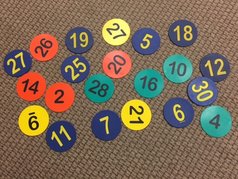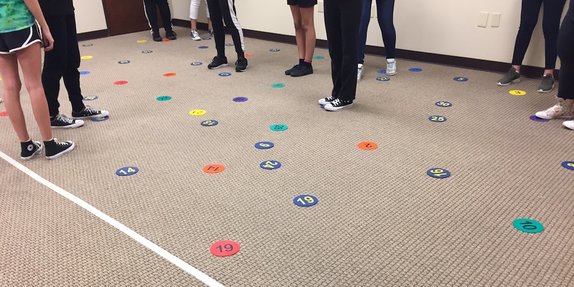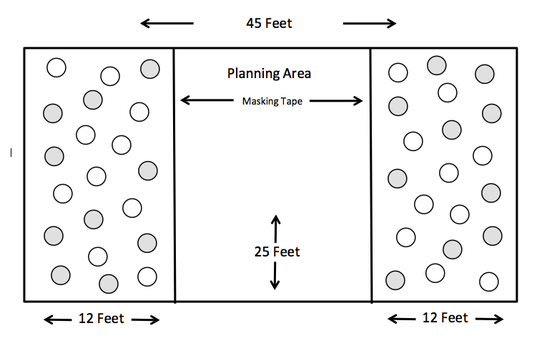
Here's what I like about this activity and overall set up:
- We were able to run groups of 16 players to 40 players (the five groups in the program were designated by certain classes from school).
- This activity can be run by one facilitator when participants are assigned to time themselves. (During this program I had a co-facilitator.)
- As the groups entered the room we had a designated - visually clear - open space (planning area) to meet so we could provide the directions.
- The directions for this one are not very complex.
- There is enough action going on so that no one is ever waiting too long to participate in some way.
- This activity can be done in 20 minutes (or more if needed) - there is enough time for each play area group to attempt the task at least three times. With multiple attempts there is enough time to do some simple problem solving and see improvement (just about the right amount of time to keep middle schoolers engaged and active).
- The activity can be set up as cooperative within each play area (overall time - when both animals get into the bucket), or it can be set up as competitive within play area groups or between the two play areas. So, depending on the objectives for your program you have some flexibility).
The smallest group from the school included 16 participants, the largest group had 40. With the first group we had at our station we divided them in half - as they entered the Key Punch room we asked them to place one foot on one of the masking tape lines on the floor. We also asked them to have an equal number of people (plus or minus one) on each of the masking tape lines). Once this was done we gave the directions:
- Your challenge is to more each of the stuffed animals in your area through the set of numbers from 1 to 30 as quickly, and safely, as you can.
- One animal in your area will be moved through the set of yellow numbers, the other animal will be moved through the set of black numbers.
- Before starting, you will need to decide which half of your group [in each play area] will work on the yellow numbers and which half will work on the black numbers. [Note to Reader: With limited time at the station we took away some of the problem solving elements.]
- Each animal must be thrown from one person to another (you can't move around with the animals). The person standing on the number one will throw the animal to someone standing on the number two. The person on number two throws to the person standing on number three. Three to four, four to five and so on.
- Since you don't have 30 people in your small group you will have to figure out who goes to what number after throwing the animal.
- It's okay for an animal to fall to the floor. Just pick it up and keep going.
- When the person standing on number 30 gets the animal he/she must place it (not throw it) into the bucket located on the masking line - walking swiftly and carefully. The person that was standing on the number 30 is the only person that can place the animal in the bucket. The bucket is allowed to be moved to anywhere on the masking tape line before you start the activity.
- When both animals make it into the bucket the time will be stopped.
- You can attempt the activity as many times as you would like before you have to move to the next station.
- Take a little time to plan. When you are ready to be timed tell your facilitator. On the word, "GO" the animals can start flying.
Since we had white boards and markers in the room we were able to write down the times for each attempt. I wrote down the time when the first animal from my area made it into the bucket and then the overall time when the second animal made it into the bucket. This provided some good information to discuss. For example, "Could we get both animals in the bucket as fast as the first one made it in?" This question from me was meant to get them thinking about sharing ideas - collaborating.
The last point I want to share is related to the motivation factor. We challenged each group to "beat the time for the 'conference room' challenge" (this is what we called it). We kept the top two lowest times on the white boards and built up the challenge to beat one of the two times. In this way we did not encounter any competitive behaviors between the two play area groups in the room. We also encouraged and congratulated them on improving their own times. I thought these motivational approaches worked well for this middle school program.
Have FUN out there!
Chris Cavert, Ed.D








 RSS Feed
RSS Feed